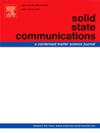WO3纳米结构的抗菌和抗癌活性研究
IF 2.1
4区 物理与天体物理
Q3 PHYSICS, CONDENSED MATTER
引用次数: 0
摘要
本文采用液压酸助沉淀法制备了三氧化钨纳米颗粒(wo3nps),采用溶胶-凝胶法制备了WO3纳米棒(NRs)和WO3纳米片(NSs)。分析了合成的纳米结构的结构、形态、振动、比表面积和孔径分布、光学、热、电化学性能、抗菌和抗癌活性。采用x射线衍射(XRD)测定了材料的相和晶格参数。合成的WO3纳米结构为单斜晶(NPs)、三斜晶(NRs)和单斜晶(NSs)。形貌分析表明,纳米粒子分布均匀,大小几乎一致,无团聚现象,纳米粒子纠缠在一起,成批生长,纳米粒子堆叠在一起。拉曼光谱和傅里叶变换红外光谱(FTIR)研究表明,WO3纳米结构中分别存在各种振动和官能团。采用BET分析法研究了其比表面积和孔径分布。计算得到WO3 NPs、NRs和NSs的比表面积分别为12.98、09.26和11.37 m2/g。利用紫外可见光谱学对其光学特性进行了研究。热重分析(TGA)表明合成的纳米结构具有较高的热稳定性。WO3网络内部的强相互作用是其在800°C前具有较高的热稳定性的原因。为了分析其电化学性能,采用了循环伏安法。研究了WO3纳米结构对金黄色葡萄球菌和大肠杆菌的抑菌活性。研究了WO3纳米结构对人乳腺癌细胞的抗癌活性。活性氧(ROS)的产生是WO3纳米结构抗毒性的主要原因。多孔结构越高,WO3纳米粒子的活性位点越多,比表面积越大。这证实了WO3 NPs与NRs和NSs相比具有更好的电化学、抗菌和抗癌性能。本文章由计算机程序翻译,如有差异,请以英文原文为准。
Investigation of antibacterial and anticancer activities of WO3 nanostructures
In this work, tungsten trioxide nanoparticles (WO3 NPs) was prepared by hydraulic acid-assisted precipitation method and WO3 nanorods (NRs) and WO3 nanosheets (NSs) were synthesized by sol-gel method. Structural, morphological, vibrational, specific surface and pore size distribution, optical, thermal, electrochemical properties, antibacterial and anticancer activities of the synthesized nanostructures were analysed. X-ray diffraction (XRD) was employed to find the phase and lattice parameters. The synthesized WO3 nanostructures were of monoclinic (NPs), triclinic (NRs) and monoclinic (NSs) crystalline phases. The morphology analyses inferred that the NPs were equally distributed with almost uniform size without any agglomeration, NRs entangled, grew up in batches and the NSs stacked together. Raman and Fourier Transform Infrared Spectroscopy (FTIR) studies indicated the presence of various vibrations and functional groups in WO3 nanostructures, respectively. Specific surface area and pore size distribution were studied by using BET analysis. The calculated specific surface areas for WO3 NPs, NRs and NSs are 12.98, 09.26 and 11.37 m2/g, respectively. Ultraviolet–Visible (UV–Vis) spectroscopy was utilized to study the optical characteristics. Thermogravimetric analysis (TGA) inferred that the synthesized nanostructures exhibited higher thermal stability. Strong interaction within the WO3 network is accounted for their higher thermal stability till 800 °C. To analyse the electrochemical properties, cyclic voltammetry measurements were conducted. The antibacterial activity of WO3 nanostructures was examined against S.aureus and E.coli strains. The anticancer activity of WO3 nanostructures was investigated on human breast cancer cells. The production of reactive oxygen species (ROS) was responsible for the efficiency of WO3 nanostructures towards toxic effect. Higher porous structure of WO3 NPs offered more active sites and large specific surface area. This authenticated the better electrochemical, antibacterial and anticancer performance of WO3 NPs, as compared to NRs and NSs.
求助全文
通过发布文献求助,成功后即可免费获取论文全文。
去求助
来源期刊

Solid State Communications
物理-物理:凝聚态物理
CiteScore
3.40
自引率
4.80%
发文量
287
审稿时长
51 days
期刊介绍:
Solid State Communications is an international medium for the publication of short communications and original research articles on significant developments in condensed matter science, giving scientists immediate access to important, recently completed work. The journal publishes original experimental and theoretical research on the physical and chemical properties of solids and other condensed systems and also on their preparation. The submission of manuscripts reporting research on the basic physics of materials science and devices, as well as of state-of-the-art microstructures and nanostructures, is encouraged.
A coherent quantitative treatment emphasizing new physics is expected rather than a simple accumulation of experimental data. Consistent with these aims, the short communications should be kept concise and short, usually not longer than six printed pages. The number of figures and tables should also be kept to a minimum. Solid State Communications now also welcomes original research articles without length restrictions.
The Fast-Track section of Solid State Communications is the venue for very rapid publication of short communications on significant developments in condensed matter science. The goal is to offer the broad condensed matter community quick and immediate access to publish recently completed papers in research areas that are rapidly evolving and in which there are developments with great potential impact.
 求助内容:
求助内容: 应助结果提醒方式:
应助结果提醒方式:


